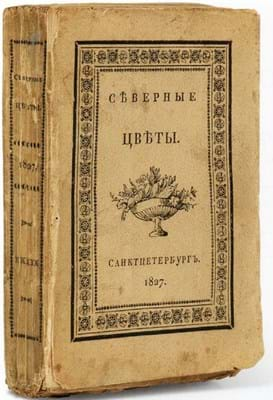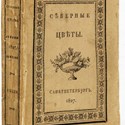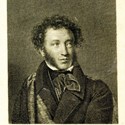Things began well when a rare first issue copy in original wrappers of Ruslan i Lyudmila, the poem that marked the beginning of the great Russian writer’s literary career, sold at a record £75,000 on December 13.
Issued in plain wrappers and without the frontispiece by Ivanov found in later issues, the book was printed in St Petersburg in June 1820, but it would be at least a year before its author could see a copy of his mock epic and enjoy the benefits of its immediate public success.
The work had been begun some three years earlier, while he was still at the Tsarkoe Tselo lyceum, and he continued to return to it between drinking and gambling bouts and fighting the odd duel. However, by the time it was published he had been forced into exile in southern Russia for writing scandalous epigrams about the imperial family.
This was the first copy seen at auction since 1994, when the Fekula example (in later printed wrappers) made $7500 at Christie’s East.
The ex-Fekula copy of his first published collection of poems, Stikhotvoreniya, made £48,000 in the King Street sale – another record.
A crisp and fresh example in a contemporary Russian binding of half calf, this volume issued in St Petersburg by the Department of Public Education is dated 1826 but had in fact been published on December 28 of the previous year, two weeks after the Decembrist revolt. The edition of 1200 copies sold out within two months.
It should have appeared earlier still, but Pushkin had lost the original manuscript in a card game in 1820 and was only able to buy it back, at 500 roubles, in early 1825 – using profits from the publication of the first part of Eugene Onegin.
Most of the other big money-spinners in this Pushkin collection were copies of almanacs containing his literary contributions.
Flowers blooms
Still in the original printed wrappers, a copy of the 1827 issue of Severnye Tsvety (Northern Flowers), one of the more famous Russian almanacs and one edited by his great friend, Delvig, sold at £23,000.
Among Pushkin’s contributions were the first appearance of two passages from the third part of Eugene Onegin.
The following year’s issue, which included among his contributions a passage from Boris Gudenov and also featured anengraved portrait of Pushkin, sold at the same sum.
Bid to £24,000 was an 1826 almanac, published in Moscow as Urania…, a pocket book for lovers of Russian literature, that contains five poems by Pushkin.
The first of five Nevski almanacs to be offered, the first edition of 1828, was bid to £22,000. The illustrations in this little work include six for Eugene Onegin – the only illustrations for the work to be published in Pushkin’s lifetime.
Of this Nevski group, the most expensive, at £35,000, was the almanac for 1828, in which Pushkin’s contributions include an illustrated passage from Boris Gudenov, the poem ‘Vozrozhdenie’ and three moralizing quatrains.


















